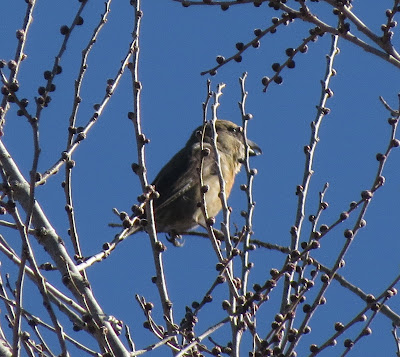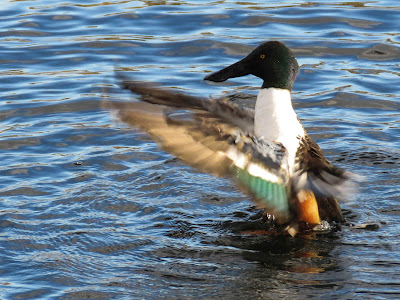Friday 28 January
 |
| Almost the same river mouth lagoon seen from the beach |
Having visited Velez Malaga for a regular hearing check-up, I decided to call in at the Rio Velez on the western outskirts of Torre del Mar on the way back to Granada province. I had already heard rumours of engineering works on the river bed but was, nevertheless, amazed to see what had been happening and was, indeed, still in progress.
 |
| A new lagoon in front of the hide |
With a "dodgy" leg I drove towards the hide but stopped almost immediately once clear of the few standing trees to look at the riverbed itself which was now something akin to a main thoroughfare having been used by heavy equipment working nearer to the beach. On the opposite of the riverbed, at lest 60 Cormorants roosting in three large trees and then, a few metres on, the fist sighting of the newly-created lagoon on what had previously been meadow land between track and river. Straight away a couple of White Wagtails and a lone Ringed Plover working the edge and the water looking clean, calm and sheltered.
 |
| A few of the three score Cormorant Phalacrocorax carbo |
Straight on to park opposite the hide and even that required a little mountaineering skill as the entrance ramp was now completely blocked with much of the roadside bamboo having been removed. From the hide it was possible to get an idea of the new layout. To my right, up river, the new lagoon with quite a steep embankment all round. In front of me a second newly-created lagoon and a third to my left. In the far distance one could still make out where the main river course would eventually reach the sea, or at least the holding lagoon until heavy rains resulted in a break through the sea itself. Looking closely it was not the pair of Mallard on the distant water that caught my attention but rather the pair of Purple Swampens working just behind the bank in front of me. The heavy bulldozer was bust at work towards the back and a single Cattle Egret was happily waiting for food to be uncovered.
 |
| Cattle Egret Bubulcus ibis |
I did continue on down the main track to the beach which was now almost completely under water with the tide well in a raging sea in front. But I took a chance and walked to what, in the past, had been the end of the river at its terminal lagoon. Again, one got a new perspective of that the finished product might look like. On the main water in front of me a score or more Mallard along with a half-dozen Moorhen and three Coot.
 |
| Distant record shot of Grey Wagtail Motacilla cinerea |
Time to make my way back to the hid and noting more White Wagtails but also a single Grey Wagtail. With the constant movement of gulls above, mainly Mediterranean but a few Black-headed, I stopped to look at the growing field towards the town and noted a resting flock of at least 400 Mediterranian Gulls. Indeed, sitting atop the nearby fence to show me the way was a Stonechat. Finally, the resident Rock Doves resting in the trees below the main bridge.
 |
| Female Stonechat Saxicola rubilcola |
Leaving this lower part of the river by the riverbed I took a short visit to the growing fields up river just beyond the N340 road bridge and added a dozen Chiffchaff feeding on the muck heap, a couple of Crested Larks and a Hoopoe. A lone Crag Martin flew past and on the wires in excess of sixty Spotless and a handful of Common Starlings.
But not all finished yet as my return journey took me via the harbour at Caleta where there was virtually no beach with the sea thundering in and as well as a good number of Yellow-legged and Lesser Black-backed Gulls there were a couple of Little Egret. In the trees of the adjoining car park no shortage of Monk Parakeets and the occasional House Sparrow.
 |
| Purple Swamphen Porphyrio porphyrio |
Birds seen:
Mallard, Cormorant, Cattle Egret, Little Egret, Moorhen, Purple Swamphen, Coot, Ringed Plover, Mediterranean Gull, Black-headed Gull, Yellow-legged Gull, Rock Dove, Monk Parakeet, Hoopoe, Crested Lark, Crag Martin, Grey Wagtail, White Wagtail, Stonechat, Common Starling, Spotless Starling, House Sparrow, Serin.
 |
| Can you see the lonely Cattle Egret on the look out for a meal? |
 |
| Never mind a few Mediterranean Gulls Larus melanocephalus! |




































